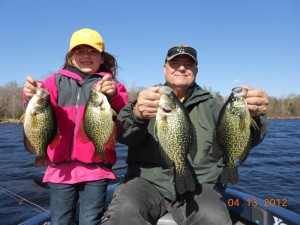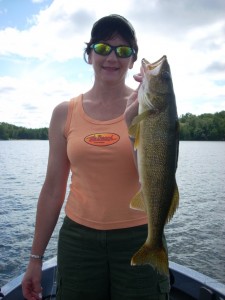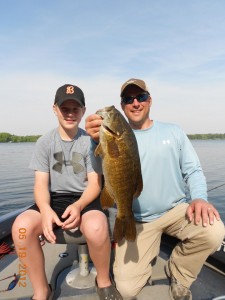Keep Your Options Open This Spring
Long time friend and legendary Hayward, Wisconsin fishing guide Terry Peterson instilled the value of an open minded approach in me years ago.
KEEP YOUR OPTIONS OPEN

As the ice thaws in northern Wisconsin, the anticipation for opening day builds. Walleye’s, crappies, bass, and pike occupy the thoughts of many fishermen. Even musky hunters, who are forced to wait a month longer for the beginning of the musky season, have the chance to experiment with other species during the early spring. This is the perfect opportunity to explore, experiment, and expand the boundaries of your fishing resume. Our lakes are like giant puzzles, and every fish caught is another piece. When you start to put these pieces in place, you will simplify the process to locating and catching fish regardless of time of year or species. Those who are able to take advantage of the various early spring opportunities often find themselves perfecting their skills later in the season when they tend to focus on specific species.
Crappies
Crappies are a great place to start the conversation. First of all, because they are not classified as a game fish in
For the best early season action, focus on relatively shallow stained water lakes with good weed growth. These lakes tend to warm up quicker and provide green vegetation before larger, clear water lakes. As with all species, water temperature is critical. The equation is simple: Warmest Water + Green Weeds = Slabs. As soon as the ice melts, schools of crappies will begin staging to spawn. Focus on shallow bays. The presence of a stream or spring inlet will usually increase your odds of finding fish. Active fish will generally be anywhere from 10 ft. to 2 ft. I prefer to start deeper and work in. Windy days tend to push fish shallower, as well as inspire their appetites.
Although many people view crappies as a “finesse” fish, you still need to be aggressive when locating them. Early spring crappies are generally not shy about letting you know if they are hungry. Don’t get stuck in one place too long without action. Keep probing until you find active fish. When trying to decide what to use, “small” and “light” are common themes. 6.5 ft. light action rods with 4 to 6 lb. test will allow you to make long casts with a clean presentation. 1/64 and 1/32 oz. jig heads dressed with a tube or grub and suspended under a slip bobber are as close to a “sure thing” that there is. White, pink, and red are personal favorites, but colors should constantly be experimented with. The jig can certainly be tipped with a small minnow, although this is not always necessary and sometimes counterproductive. Natural wave action and quick rod twitches usually provide enough enticement. Details, details…..a small split shot should be pinched on the line twelve inches above the jig. Size of the shot should be adjusted so your float barely stays above water. Crappie strikes are sometimes subtle, and proper presentation can be the difference between a limit or an empty live well. Once fish are found, drop anchor and set up. When you have located a school of “biters”, frequent moves may still be necessary. When action slows, the fish haven’t left the area. Usually, they have simply relocated short distance away. Slowly and quietly move the boat in the direction of the last fish caught and re-anchor. You should now be on them again.
Walleyes

The walleye spawn in northern Wisconsin usually coincides relative to the fishing opener. In most years, by the time opening day arrives, the spawn has just finished. An abnormally late spring or thaw may sometimes push the spawn into the first two weeks of the season. Either way, just as “Mother Nature” can be a fickle lady, so too can early season “eyes”. Smaller males tend to be the most accessible at this time as larger females are recovering from the rigors of the spawn. Depending on the water system you are on, fish can literally be anywhere. Although this is not a very encouraging response, there are several things we can do to narrow the search.
First, we need to understand spawning locations on a particular body of water. In reservoirs, walleyes tend to migrate “up stream” as far as possible, spawning along rocky shorelines near a dam or other barrier. In natural lakes, walleyes need windswept, gravel and rock shorelines or reefs to complete their annual commitment. A quick study of a quality lake map should reveal likely locations. Actively spawning fish can be very shallow, particularly in low light conditions. Efforts should be focused on ten feet of water or less with two approaches being effective. Fan casting crank baits and stick baits provides a great search tool for active fish. Thoroughly cover presumed spawning grounds with long casts while constantly changing speed as well as switching between straight and erratic retrieves. Suspending stick baits can be especially effective at this time. A 7 ft. medium action rod and reel loaded with 8 lb. test will be up to the task. Walleyes feeding in shallow water tend to strike aggressively, and you will have no doubt when bit.
Active shallow walleyes can also be caught on jig and minnow combinations. I prefer 1/16 oz. to 1/8 oz. jig heads tipped with a large fathead or 4 inch sucker minnow. My preferred jigging combination includes a 6.5 ft. medium light action rod and reel spooled with 6 lb. test. Strive to present your bait as naturally as possible while hopping it along the bottom or using a more pronounced lift and fall retrieve. Again fan cast likely areas, and don’t be timid. Shallow spring walleyes tend to be aggressive. If you aren’t getting bit, move on.
Haven’t found fish yet? Move out, or down if in a reservoir. If the spawn has completed, fish are in “recovery mode”. Fish in reservoirs will slowly progress back down stream until they reach their summer haunts. Points, rock piles, channel edges and adjacent flats are all likely places to search. On lakes, fish are usually located anywhere between 12 and 35 feet. Focus on major structural features such as humps and points, working your way out to main lake basins where it is not uncommon to find fish exactly where we left them in the fall. In this scenario, quality electronics are a must. Not only will they reveal fish, but you will also be able to pinpoint structure. Precise presentation is necessary as recovering fish often need to size up an offering before deciding to eat. Fish will likely be on or very close to bottom, so don’t expect to see pronounced “arcs” on your screen. Look for a thin line or bump barely separated from the bottom on your screen. Present a jig and minnow combination slowly with frequent long pauses between movements. Once you have confidently located fish, a slip bobber presentation can also be employed to trigger fish that are particularly stubborn.
Smallmouth Bass
There may be nothing more satisfying after a long winter than setting the hook into the first football sized bass 
Unlike walleyes, smallmouth bass are in a completely different situation at this time of year, even though their paths are crossing. Smallies spawn when water temps reach the high 50’s. Generally, that tends to be in late May and early June. Therefore, any fish caught at this time are in “pre spawn” mode. The most effective tactic involves finding the warmest water closest to known spawning flats and shorelines. The north side of lakes and bays receives the most sun exposure, and that is exactly where you should start your search. Effectively locating smallmouth often includes a lot of visual scouting. Spawning nests from the previous year are usually still visible. Although silted in, many tire shaped nests can still be seen, and bottom composition is the key. In most lakes, smallmouth will prefer sand, gravel, and scattered rock (baseball to softball sized). Even if you only locate a few nests, you are on the right track. Now it is time to back off.
Pre-spawn smallmouth will stage on the first main break (5 to 20 ft.) adjacent to the spawning area. Retreat to this zone, and employ a 3 step approach. Extremely active fish will be cruising at or near the warmest surface water. These fish will be highly vulnerable to suspending stick baits, often striking on exaggerated delayed pauses. This is a fast and effective way to cover water as well as locate the most aggressive fish in the lake. Moderately active fish are generally suspended in the middle of the water column. A slow falling fluke or wacky rigged worm will draw the attention of these fish. Slight twitches or shakes during the fall will seal the deal. Finally, fish that are not considered active will be hugging bottom. Tried and true, this is where the tube jig earned its stripes. Probably one of the most effective smallmouth lures in history, tube jigs are impossible to resist even for the moodiest of bass. Use a natural color (my choice is usually “smoke”) matched with a 3/8 oz. head, and you are in business. Hop it, swim it, drag it…..anything goes. One thing to note, at this time of year, smallmouth are usually found in small schools or “packs”. Once a fish is hooked, continue to thoroughly fish the area. This will often result in another quick hook up. A 7 ft. medium action spinning rod and reel spooled with 8 lb. test line will serve as a great multi-purpose outfit that will adequately present everything mentioned as well as handle these incredibly athletic fish.
Pike

Of all the species we have discussed, pike are the earliest to spawn. They have even been known to spawn under the ice during late winter. By the time opening day arrives, they are usually beyond recovery, and on the feed. It is no surprise that many opening day catches are heavy on pike. Using the information discussed earlier in this article, and combining it with a raging metabolism, we can be sure of one thing…pike will be everywhere! All that remains is deciding how and where to fish.
Pike spawn in shallow weedy bays, inlets, and outlets. Your best chance of connecting with a truly large early season fish would be to focus on these areas. Large females are not quick to leave, and they generally “rule the roost”, running out smaller fish. Most fish will be located in less than 10 ft. of water. If those bays happen to hold schools of spawning crappie or perch, better yet. Spinner baits, shallow diving stick baits, and spoons will all produce fish. Work these areas thoroughly while paying special attention to weed edges and secondary points.
Don’t overlook live bait. A 6 to 8 inch sucker minnow suspended under a float is irresistible to any pike looking to indiscriminately pack on the pounds. Use the wind to drift your presentation through weeds, along edges, and across points. Your minnow should be set half way between bottom and your float.
15 to 20 lb. braided line on a medium bait casting combination will get the job done in most situations, and a 9 inch wire leader will avoid lost fish to razor sharp teeth. Big pike in shallow water will immediately try to bury you in the weeds. Be aggressive when setting the hook, and don’t be afraid to “lean on them”. Big pike will make long runs, and will do whatever it takes to avoid entering your boat.
Lessons Learned
Long time friend and legendary Hayward, Wisconsin fishing guide Terry Peterson instilled the value of an open minded approach in me years ago. On occasions we were able to fish together, I would ask Terry the obvious question, “What do you want to fish for?” Terry would often respond, “Let’s just fish.” We often had no agenda and would simply let one bite lead us to the next. Although this approach may not have always produced immediate rewards, the long term lessons learned were invaluable. By broadening our horizons, we were actually narrowing the process to targeting specific fish.
Many anglers have a preferred fish or “favorite fish” that occupies most of their time on the water. Whatever the reason, this passion keeps us striving for more information to put more fish in the boat. Most would agree, that not “all fish” are biting “all of the time”. When possible, take advantage of this reality by considering all of your options. You will not only expand your fish catching opportunities, but you will also gain deeper insight into your preferred target species. Early spring is a great time to explore these options and gain a more intimate knowledge of the lakes you are fishing. Who knows? You may even find a new “favorite fish”.
Jeff Evans

